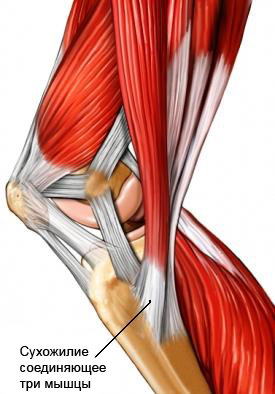Anzerinovy bursitis – Бурсит "гусиной лапки"
Description bursitis “crow's feet”
Anzerinovy bursitis – pain in the inner part of the leg, just below the knee joint, in place of, where three tendons attached to the bone. The muscles include the sartorius, thin, and semitendinosus. At this point, there are also several shopping bags (grant) – fluid-filled sacks, which reduce the friction between the bones and muscles.
When inflamed bags, This condition is called bursitis. When inflamed tendon – Tendinitis. The cause of this syndrome is unknown, but it may also occur after trauma or inflammation of tendons or bags. Prognosis positive, it may be cured.

Reasons anzerinovogo bursitis
This disorder most often occurs due to multiple loads on the knee. This injury is common among runners. It is also common among people with such diseases, as:
- Obesity;
- Knee Arthritis;
- Diabetes.
A knee injury can also cause this disorder.
Risk factors
Factors, which increase the likelihood of bursitis anzerinovogo:
- Jogging;
- Osteoarthritis;
- Torn meniscus;
- Obesity;
- Changes in the loads on the legs:
- Slog;
- The sudden increase in the load on the legs;
- Sensitive hamstrings;
- Flatfoot;
- Diabetes;
- Strong wrapping the foot inside (Strong pronation).
Symptoms of bursitis anzerinovogo
These symptoms can also be caused by other diseases. You must inform your doctor, if they came any.
- Pain in the inner part of the knee;
- The sensitivity of the knee;
- Swelling;
- Increased pain when bending and straightening the knee;
- Pain increases during exercise.
Diagnosis of bursitis anzerinovogo
The doctor asks about the symptoms and medical history, and performs a physical exam. The diagnosis is made primarily on the basis of inspection, but sometimes it is an X-ray knee, for, to rule out other diseases.
Treatment for bursitis anzerinovogo
Treatment involves the following procedures:
Recreation
It is necessary to reduce the load on the injured knee. You can also apply ice to the knee 3-4 once a day, to reduce inflammation.
Medications
Nonsteroidal anti-inflammatory drugs (NSAIDs) can reduce pain and inflammation. The doctor will advise, NSAIDs have to take and how often. You can also use steroid injections directly into the knee, to reduce pain and inflammation.
Prevention anzerinovogo bursitis
To reduce the likelihood of developing bursitis anzerinovogo, it is recommended to perform the following actions:
- If necessary, increase physical activities, do it gradually;
- Stretch the muscles before and after workouts;
- It is necessary to wear comfortable shoes.
